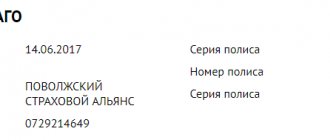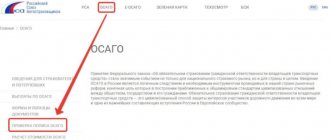If suddenly a traffic inspector stops a car, this causes mental anxiety even among those vehicle owners who have all their documents in absolute order. But, most motorists realize: while the requirement of traffic police officers to show them a driver’s license and papers for vehicle ownership is quite understandable, the requirement to present an insurance policy causes misunderstanding. “Is the driver obligated to present an insurance policy to the traffic police inspector?” — the answer to this question is contained in this article.
When is insurance presented to a traffic police officer?
According to the traffic rules, the insurance protection policy must be presented to the traffic inspector when the obligation under compulsory motor liability insurance is regulated by the Federal Law. A motorist must provide documents for inspection to a traffic police officer in all cases when the inspector legally brakes his car.
During scheduled flights, such a check is not imposed by law, but, understanding the specifics of the traffic police, it is still wiser for motorists to provide documents. For traveling without insurance, a penalty is imposed: there are no objective reasons not to show the policy. Not in all situations the traffic inspector can check the compulsory motor liability insurance. Thus, the question of the necessity/legality of such checks does not lose its relevance today.
When traffic inspectors stop a vehicle to check documents, they are often not asked to provide insurance because they can independently carry out a check using the RSA database.
What to do when the electronic MTPL policy is not accepted by a traffic police officer?
Sometimes it happens that a traffic police officer for some reason does not want to accept a printout or photo version of the electronic OSAGO policy. On the one hand, such paper is really not a document. In addition, such copies often cause mistrust. In this situation, you can ask the inspector to contact specialized services. The check will not take much time. If he refuses, citing lack of access to the database, then this is no longer the driver’s problem. In any case, the issued fine can be easily appealed (of course, if the policy number is actually present in the registry). Similar cases have already been encountered, and, as a rule, the vehicle owner was found to be right.
Is it necessary to show insurance to a traffic cop in Russia in 2021?
Many novice drivers are interested in: do they need to show paper insurance to a traffic cop in Russia? Starting in 2021, the State Duma approved in the first reading a useful bill prohibiting the presentation of regressive compulsory insurance requirements to pedestrians who are at fault for road accidents in which they were injured.
This bill equalizes the importance of electronic/paper policies: they will be considered a single type of compulsory motor liability insurance. Then, to the question: “Is the driver obliged to present insurance to the traffic police inspector in a paper version?”, the answer will be negative. The only thing that motorists will need to present to traffic cops is the number code of the MTPL policy.
Attention! If such an initiative is approved, then all compulsory insurance (paper/electronic format) will receive a unique number code. Using this code, traffic cops will check for the presence of a document: drivers in Russia will have to show the OSAGO number on the phone screen, or dictate it. The inspector will only have to “check” the insurance through the electronic database.
If the amendments are adopted, the inspector will not be able to require the provision of paper insurance, and insurance companies will be able to significantly save on purchasing from the State Insurance Company. sign" of expensive strict reporting forms equipped with special protection. At the same time, the legal norm that allows you to obtain insurance from an insurance company on company letterhead will remain. This means that an absolute transition to an electronic vehicle license on the territory of the Russian Federation will not happen in the near future.
Article on the topic: Recourse claims under compulsory motor liability insurance from the insurance company to the culprit of the accident
The State Duma adopted the document in the first reading, then the initiative will undergo the main second and third readings. If the initiative is approved, it will only come into force six months after its official publication.
Accordingly, if acceptance happens “without rough edges,” real changes will become noticeable. And, the situation today is such that drivers, while on the road, are required to carry with them either an ordinary paper policy or a printed electronic one.
What is the purpose of insurance?
The service for issuing electronic MTPL was introduced back in 2015, and gradually expanded its scope of use among motorists. Since the beginning of 2021, the law has obligated insurance companies that have received licenses in the field of compulsory motor liability insurance to provide any vehicle owner who applies with an application with the opportunity to conclude a compulsory motor third party liability insurance contract electronically. This information suggests that the legislator is moving towards improving regulatory regulation, as well as the practical application of this issue.
The point of switching to electronic insurance is to gradually move away from the paper document management system in the field of vehicle operation. The use of this innovation can significantly simplify the procedure for purchasing insurance and, accordingly, save citizens’ time in obtaining it.
Reference! The electronic insurance system is based on entering a record into the RSA information base based on information from the concluded insurance contract. Thus, all necessary data is stored electronically; there is no paper version.
The main purpose of electronic insurance is to replace the paper version of the document. This process has the following features:
- Checking the availability of insurance and any registration actions must be carried out through access of government departments (traffic police, customs, etc.) to a unified information base.
- A citizen can make insurance on their own without leaving home.
- The cost of producing special forms is reduced.
What documentary package should be provided to traffic police officers upon request in 2021?
The text of the code of laws “on compulsory motor liability insurance” clearly states that every motorist is a person obliged to provide his own insurance in three situations:
- in case of an accident;
- in case of non-compliance with traffic rules;
- when deregistering a car.
Clause 2.1.1. The traffic rules answer the question in the affirmative: does a traffic inspector have the right to carry out an inspection? When carrying out the check, the traffic police officer must: introduce himself, indicate his position, indicate the reason for the braking.
Accordingly, the reciprocal responsibility of the vehicle owner is to provide a documentary package consisting of:
- driver's license;
- documents having registration value;
- insurance policy.
This list is mandatory for all drivers, regardless of the situation. Answering the question: “Does a traffic police officer have the right to demand to see the above papers?”, the answer will be positive. In turn, the driver is obliged to present the MTPL to the traffic inspector. At the same time, the insurance must not be expired, and the driver specified in the policy must be in the driver’s seat.
The legislative framework
The law “On Compulsory Motor Liability Insurance” regulates the entire range of issues regarding compulsory insurance.
Following this law (clause 1, article No. 4), all motorists are required to draw up agreements on compulsory motor liability insurance. Otherwise, the vehicle is considered unsuitable for driving on public roads.
Contents of clause 2.1.1., art. No. 2 of the traffic rules informs the following: when driving a car, the driver is obliged to take with him and also provide the traffic inspector with his insurance. But, at the same time, the traffic inspector must have objective reasons for carrying out an inspection of the person behind the wheel.
Contents of paragraph 106 admin. The traffic police regulations say that such requirements include:
- fact of recording a traffic violation;
- the fact that there are guidelines for a specific vehicle;
- the fact of carrying out specialized actions/operations aimed at preventing road accidents;
- the fact that the driver violated the requirements for safe driving (heavily tinted windows, etc.).
The content of clause 84.13 of the Administrative Regulations of the State Traffic Inspectorate informs that the traffic inspector has every right to slow down the car to audit documents for the ability to drive the vehicle, as well as papers for the car.
You should know! If desired, the traffic police officer can easily find many reasons to check the documentary package: at the same time, the driver cannot refuse.
Checking the MTPL policy of the traffic police - in what cases is an insurance policy provided?
For a long time now, traffic police inspectors have not checked drivers’ technical inspection cards (diagnostic cards). But what about the MTPL insurance policy? Do I need to present it to the traffic police officer? Are there any situations when the traffic police inspector does not check the MTPL policy? What should you do if an employee asks you to hand over the policy to him for verification? What should those who insure civil liability using an electronic policy do?
The legislative framework
According to paragraph 1 of Article 4 of Federal Law No. 40 “On compulsory civil liability insurance of vehicle owners,” all car owners are required to enter into a compulsory motor liability insurance agreement. Otherwise, the car is not allowed to drive on public roads. At the same time, paragraph 2.1.1 of Article 2 of the Road Traffic Rules established that when driving a vehicle, the driver is obliged to have with him and hand over to the traffic police inspectors upon request, including an MTPL insurance policy. However, the traffic police officer must have sufficient grounds to be able to check the driver’s documents. Paragraph 106 of the Administrative Regulations of the State Traffic Safety Inspectorate determined that such grounds include:
- Recorded violation of traffic rules;
- Availability of vehicle orientation;
- Carrying out promotions and special operations aimed at preventing road accidents and reducing the severity of the consequences of road accidents;
- Violation by the driver of the requirements for ensuring the proper level of safety on the road (excessive tinting of windows, “playing checkers”, etc.).
In addition, clause 84.13 of the Administrative Regulations specifically stipulates that the traffic police inspector has every right to stop a vehicle in order to check the driver’s documents for the right to drive a vehicle and documents for the car itself. In practice, this means that, if desired, the traffic police inspector can always find a reason to check the driver’s documents and he will not have the right to refuse him.
Liability for lack of insurance
Responsibility for the lack of a compulsory motor liability insurance policy is determined by Article 12.3 of the Code of Administrative Offenses. Paragraph 2 of this article states that in case of failure to provide a police officer with an MTPL policy, the driver faces a fine of 500 rubles or a warning. At the same time, paragraph 2 of Article 12.37 of the Code of Administrative Offenses of the Russian Federation determined that if the driver drives a vehicle for which a compulsory motor liability insurance contract has not been concluded, the fine is 800 rubles without the possibility of replacing the fine with a warning. Also, paragraph 1 of the same article determined that if the vehicle is driven in violation of the requirements established by the car insurance contract (the car is driven by a driver who is not included in the insurance, or the car is driven during a period of time not covered by the insurance), the driver will be fined in the amount 500 rubles.
Features of an electronic document
From January 1, 2021, car owners have the opportunity to buy an electronic OSAGO policy. To do this, you need to go to the official website of the insurance company, fill out the appropriate form, pay for the policy and submit the application. But in this case, the insurer is not obliged to provide the client with a paper version of the policy. In fact, when driving a vehicle, the driver is left without a compulsory motor liability insurance policy, for which liability is provided under paragraph 2 of Article 12.3 of the Code of Administrative Offenses of the Russian Federation (a fine of 500 rubles or a warning). However, paragraph 124 of the Administrative Regulations of the State Traffic Safety Inspectorate determined that the driver can transfer to the traffic police inspector a printed version of the electronic OSAGO policy. That is, the driver needs to download the electronic policy he purchased (the insurance company sends it to the specified email) and print it on a regular printer.
Also, as of 2021, traffic police inspectors are testing a service for checking whether a driver has MTPL insurance policies without providing a paper version. That is, the employee enters data about the car into the search bar and the system provides information about the presence (absence) of a compulsory motor liability insurance policy and its conditions (permitted period of use of the vehicle, the number of persons included in the insurance, etc.). This innovation is primarily dictated by the widespread use of electronic MTPL policies and the fact that car owners do not always print out a paper version of the insurance.
Basic verification rules
The employee who stopped the vehicle must approach, introduce himself and state the reason for the stop. If this reason does not coincide with the above, the inspector does not have the right to check whether the driver has an MTPL policy. For example, if the car was stopped in order to attract the driver as a witness, in order to assist other road users, and so on.
If the reason for the stop coincides with the above, the inspector may require documents from the driver. He, in turn, is obliged to transfer them immediately. Clause 53 of the Administrative Regulations determined that documents are accepted from the driver without covers and holding devices. This means that the inspector has the right to take documents and go with them to a patrol car (stationary patrol post) to check all the necessary information against the database.
Conclusion
While driving on public roads, the driver must always have a paper version of the MTPL policy with him, regardless of how he purchased insurance: at the insurer’s office or online. If the driver does not have a policy in hand, a fine of 500 rubles is provided (provided that the car itself is insured). Perhaps in the near future, drivers will be freed from the need to show traffic police officers their MTPL insurance policy—an automatic information verification service is already being tested.
Is it necessary to have an insurance agreement in a car?
Many car enthusiasts are interested in: “Is it the responsibility of the autopilot to monitor the presence of the MTPL policy in their car?” The traffic rules do not regulate the form in which the insurance policy should be stored and provided to traffic police officers. The problem is complicated by the fact that most people apply for compulsory motor liability insurance online, receiving it electronically via computer mail.
Related article: OSAGO policy for foreigners in Russia, is insurance needed and how to get it
For a deciphering of the requirements of the traffic rules clause 2.1.1., informing about the storage/provision of mandatory insurance coverage to traffic inspectors, you should contact the RSA website, which states the following: store/display insurance for inspection to traffic police officers, should be in paper form.
Attention! The E-OSAGO policy must be printed. The paper equivalent of electronic insurance must mirror the entire information base of its digital original, and all data must be easy to read.
If the driver is not the owner of the car being used, the owner’s electronic insurance is not considered adequate. The owner of the car must draw up a separate agreement on compulsory motor liability insurance, taking into account the entire period of use of the car, otherwise the traffic inspector may impose penalties: on the owner/on the illegal driver.
The following fines are paid:
- for driving without a policy – 500 rubles;
- for failure to issue a policy – 800 rubles;
- for driving a car during a period not specified in the insurance – 500 rubles;
- for a driver who is not listed in the insurance – 800 rubles.
You have issued an electronic MTPL policy – what to show and how to present it to the traffic police inspector?
- You cannot present a file from your phone or not submit anything at all for a traffic police check.
- The only legally correct option is to show a printed electronic MTPL policy.
- At the same time, it does not matter whether the printout is black and white or color, and the size does not have to be A4.
- But there is no fine for failure to submit - as indicated by the Supreme Court of the Russian Federation.
The problem in 2021 is that the current version of the traffic rules obliges the driver to hand over to the traffic police officer, in addition to the STS and driver’s license, an insurance policy. But what if you have issued an electronic MTPL, how to properly present it to the traffic police inspector? Is it possible to show a file from a phone? Do I need to print it? Or, in this case, nothing needs to be submitted for verification? Let's find out all this!
How do traffic police officers check your insurance policy in 2021?
Everything is very simple. The current clause 2.1.1 obliges you to hand over for verification (namely hand over - in hand, and not just show):
- driver's license,
- registration certificate,
- OSAGO policy.
If with the first 2 points everything is extremely clear - although, according to the new laws, electronic rights are about to come, and after them the IT format can be acquired by STS, then with electronic insurance - not so much.
Many drivers suggest various options for the legal implementation of this paragraph of the Rules:
- show the traffic police inspector a photo of the electronic compulsory motor liability insurance,
- present a printed file,
- don’t show anything, because the policy is electronic!
But not all car enthusiasts from the above points are right. Moreover, you will often find incorrect information on various forums that you can display an electronic contract directly from your phone screen.
By the way, in 2021, almost any traffic police officer on the road has access to the electronic database of insurance contracts of the RSA (Russian Union of Auto Insurers). And he (the employee) can check the availability of insurance against this base.
Basic rules of MTPL inspection
The traffic police inspector who stopped the car must take the following actions, according to Pr. No. 185, paragraph 19-20:
- Introduce yourself, indicating your title, position, and full name.
- State the reason/purpose of the stop.
- Show your ID if the driver requests it.
If the stated reason is neither an accident, nor a traffic violation, nor the deregistration of the vehicle, the inspector has no reason to check whether the person driving has compulsory motor liability insurance. For example, when a car slows down with the intention of using the driver as a witness, to assist third-party road users, etc.
When the reason for braking a vehicle coincides with the above reasons, the traffic cop has the right to demand that the driver present a standard insurance policy.
Important information! The Administrative Regulations (clause 53) determine the following: all documents must be accepted without covers/other holding devices. The inspector can take the document and go with it to the patrol car for the purpose of auditing the database.
Letter of the law
Let’s not be unfounded - in order to know exactly what to show and how to present the electronic MTPL policy to the traffic police, let’s turn to the regulatory framework.
- According to the Law “On Road Traffic Rules” (Section 2 General Responsibilities of Drivers), paragraph 2.1.1 (1), the driver is required to have with him and, at the request of the traffic police officers, submit a compulsory motor liability insurance policy for inspection. The latter can be represented:
- on paper;
- in the form of a digital document;
- or in the form of a copy on paper.
- A footnote about the electronic format was added on December 21, 2019 by Decree of the Government of the Russian Federation, which is reflected in paragraph 7.2 of Article 15 of the specified federal law (“On Traffic Regulations”).
Here is a link to the law: https://www.consultant.ru/document/cons_doc_LAW_2709/a4b879c29ebc2ff9a56a0595499b6eb2dce7980e/.
So, what conclusion can be drawn? What should you show to the traffic police officers - an electronic MTPL on your mobile screen or, nevertheless, show a printed version of it?
According to the law, the driver has the right to display the policy on a digital medium. An electronic copy must be sent to the car owner’s email upon registration. It should be retained and made available when necessary.
Possible problems when using an electronic OSAGO policy
Until electronic policies were introduced, any driver had to take with him insurance the size of an A4 sheet, certified by the insurance company. After presenting the insurance, the traffic police inspector checks the insurance for its authenticity, checking the information from the VU.
Attention! Today, all Russians driving are required to have a printout of the electronic policy in order to demonstrate it at the direction of the traffic inspector. If there is no policy (or the term has expired), the traffic cop issues a fine.
“At the dawn” of the creation of services, the procedure for obtaining/using electronic policies was associated with a lot of problems. For example, some insurance companies on their websites offered to buy compulsory motor liability insurance, but at the same time, the services worked with large delays. Many insurance companies deliberately created similar obstacles in the implementation of electronic sales of compulsory motor liability insurance due to the fact that when registering online, it is not possible to sell insurance to the owner of the vehicle, with an increased set of additional options. services.
Related article: Car insurance under MTPL, what its cost depends on and where it’s cheaper to get it in 2021
Today there is an active fight against fraud in the field of online insurance. The main problems of using E-OSAGO have already been successfully resolved.
This policy has many advantages:
- there is no registration fee;
- is issued in an accessible and prompt manner;
- easy to print.
It is especially convenient to issue an electronic policy for people living at considerable distances from the offices of the insurance company: you just need to look at the “territory” of the insurer’s website and send the required information. When registering for E-MTPL, the previously accumulated bonus-malus coefficient does not go away.
The only difficulty with electronic insurance is that there is no possibility of making adjustments to the insurance contract. It is impossible to add/remove drivers or change passport details via the Internet: to do this you will have to go to the IC office. But there is hope that this problem will be solved in the near future.
The traffic inspector does not want to accept E-OSAGO: what to do?
Many motorists complain: when a printed electronic OSAGO policy is presented to a traffic police inspector, he turns out to accept it.
Helpful information! Today, such insurance is not recognized as an official document, and its printed copy often causes a “fit” of mistrust among traffic cops. In this situation, the motorist must ask the traffic police officer to contact the services of a specialized service.
Audit of electronic insurance does not require much time. If a traffic cop refuses to contact the service, explaining this by lack of access to it, then this is no longer a problem for the person sitting behind the wheel. It is easy to cancel the imposed penalty in the case where the OSAGO number code is actually entered into the register.
How does a traffic police officer check an electronic policy?
The inspection process for electronic insurance is similar to the inspection process for regular standard insurance. If, during an inspection of electronic insurance, the inspector has complaints, he must contact the IMTS or the RSA database: the VIN will be required, as well as the state registration number. vehicle number. In the same way, you can check using the number code on the printout.
Are electronic police policies valid for the traffic police?
For the traffic police, as for any other government organizations, e-OSAGO has full legal force. That is, no official, including a traffic police officer, can refuse to accept an electronic MTPL policy, citing the fact that there is no regular version. According to RSA representatives, there was only one precedent when an inspector issued a fine for electronic insurance. This decision was challenged in court.
Currently, at the request of a traffic police officer, you need to show a printout of the electronic policy or compulsory motor liability insurance in electronic form (from the screen of a phone, tablet or any other device). It can hardly be called a full-fledged document, but it is used in exactly the same way as a regular policy. More details about the mechanisms and methods for checking an electronic MTPL policy will be discussed below.
The driver does not hand over the insurance policy: what actions will be taken by the traffic inspector
Insurance issued in accordance with all the rules does not relieve you of the obligation to take it with you when driving a vehicle. Before setting off, all drivers must ensure that they have a set of basic documents, including: papers for the car, for the person driving, and an insurance contract.
Neglect of this requirement entails administrative punishment, including drawing up a protocol on the fact of the offense (clause 2, article No. 12.3 of the Administrative Code). Nowadays, traffic cops cannot use such punitive measures as: evacuation of the vehicle to the impound lot, unscrewing license plates.
Attention! The only method of censure is a fine in the amount of 500 rubles. If there is no insurance for the first time, the traffic police officer may limit himself to only a verbal warning.
Often, as a result of an inspection, it is discovered that the car is being driven by a citizen who is not listed in the policy.
In this situation, the traffic cop can impose a fine on both defendants, the driver and the owner of the car:
- for the fact of providing a car to a third party who has no reason to do so - the owner of the vehicle.
- for the fact of lack of necessary insurance papers - to the person driving the car.
Compulsory insurance has been a mandatory element of the basic package of documents for many years: every Russian motorist should have it in their hands. Taking out insurance online can eliminate the burden of printing/storing a copy of E-OSAGO on paper.
How will traffic police officers check e-OSAGO, what to show?
In accordance with the traffic rules, it is the responsibility of any car owner to ensure that he or she has a motor liability policy with him or her to present to the road inspector.
The procedure for checking the fulfillment of this duty by traffic police inspectors is regulated by Article 32 of Federal Law No. 40-FZ “On Compulsory Motor Liability Insurance”. According to this norm, control is carried out by officials:
- during registration actions in relation to a vehicle;
- in the implementation of their powers in the field of road safety.
Article 32 also establishes that a citizen operating a motor vehicle must have available for presentation to a police officer:
- MTPL policy (when taking out regular insurance);
- printout of information on the conclusion of a compulsory insurance contract (if there is a contract in electronic form).
The absence of a document in accordance with the Code of Administrative Offenses of the Russian Federation is recognized as an administrative offense and entails the imposition of an administrative penalty on the driver - a fine.
Thus, the legislation clearly regulates this issue - a document confirming the availability of insurance is mandatory. In what form should it be presented?
A literal reading of Article 32 leads to the conclusion that:
- In the first case, when issuing a paper OSAGO, the original document must be presented. A copy of the insurance policy cannot be accepted by the inspector.
- If you have an MTPL policy received in electronic form, of course, there is no question of the original document. Drivers must print out the electronic document and carry a copy of it with them to present it at the request of inspectors.
The procedure for checking insurance is also regulated by the internal letter of the State Traffic Safety Inspectorate dated 07/03/2015 No. 13/12-у-4440, which after its publication was sent to all departments of the department. This document instructed officials to carry out the procedure for checking the availability of car insurance through the special IMTS resource of the Ministry of Internal Affairs of Russia or the official portal of the RSA.
In the letter in question it was also specifically noted that to hold accountable for the lack of a policy under clause 2 of Art. 12.3 of the Code of Administrative Offences, if there is data on e-OSAGO in the system, it is unlawful.











